Abstract
Isometric performance at 29degreesC was measured in left ventricular trabeculae carneae from young adult (6-mo) and aged (25-mo) rats (n equals 18 in each group). Active tension and maximal rate of tension development did not differ with age, but contraction duration was 255plus or minus6 ms in the young adult and 283plus or minus6 ms in the aged group (P less than0.001). Although catecholamine content per gram heart weight was less in the aged myocardium, additional experiments showed that neither 1 times 10-6 M propranolol nor pretreatment with 6-hydroxydopamine eliminated the age difference in contraction duration. To determine if this age difference resulted from a prolonged active state, electromechanical dissociation and the overshoot of contraction duration during recovery from hypoxia were measured. During paired stimulation greater mechanical refractoriness was found in aged muscles (P less than0.01), but intracellular action potential recordings showed no age difference in the electrical refractory period. On recovery from hypoxia, contraction duration overshoot was 117plus or minus 4percent of control in the young and 138plus or minus 4percent of control in the aged muscles (P less than0.01). The greater electromechanical dissociation and greater overshoot in contraction duration following hypoxia in aged myocardium suggests that prolonged contraction duration in aged myocardium results from a prolonged active state rather than changes in passive properties or myocardial catecholamine content.
Full text
PDF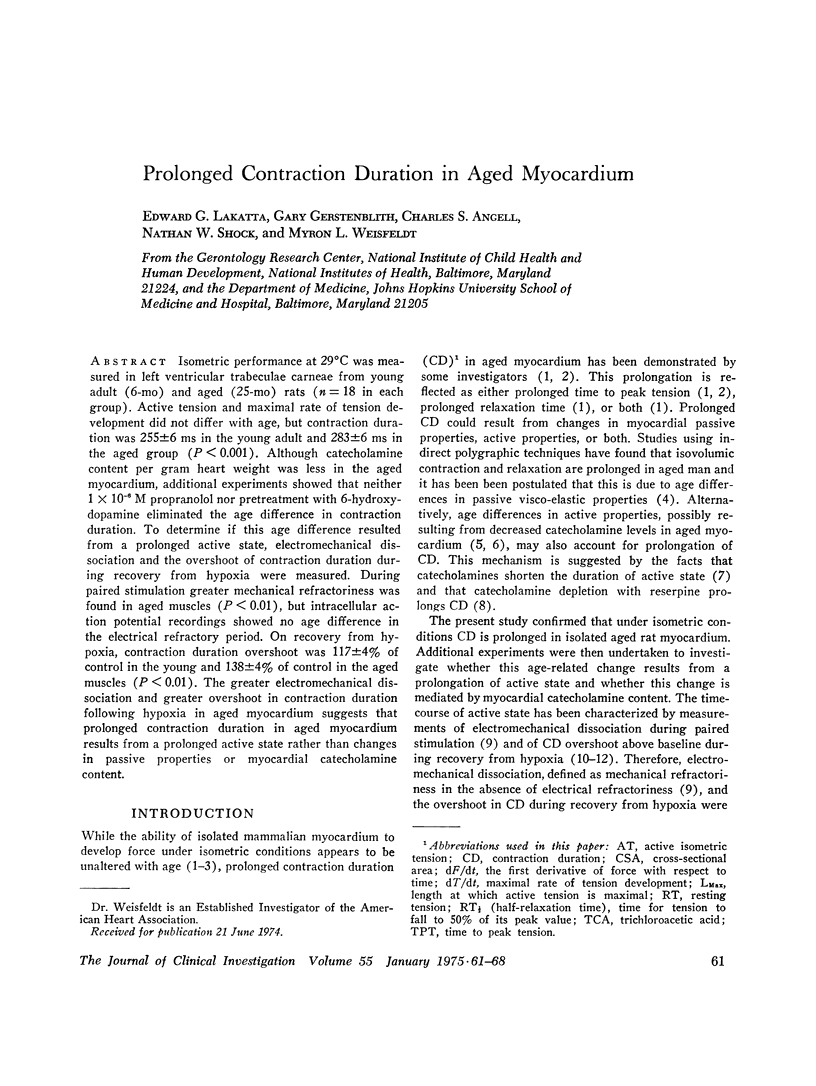
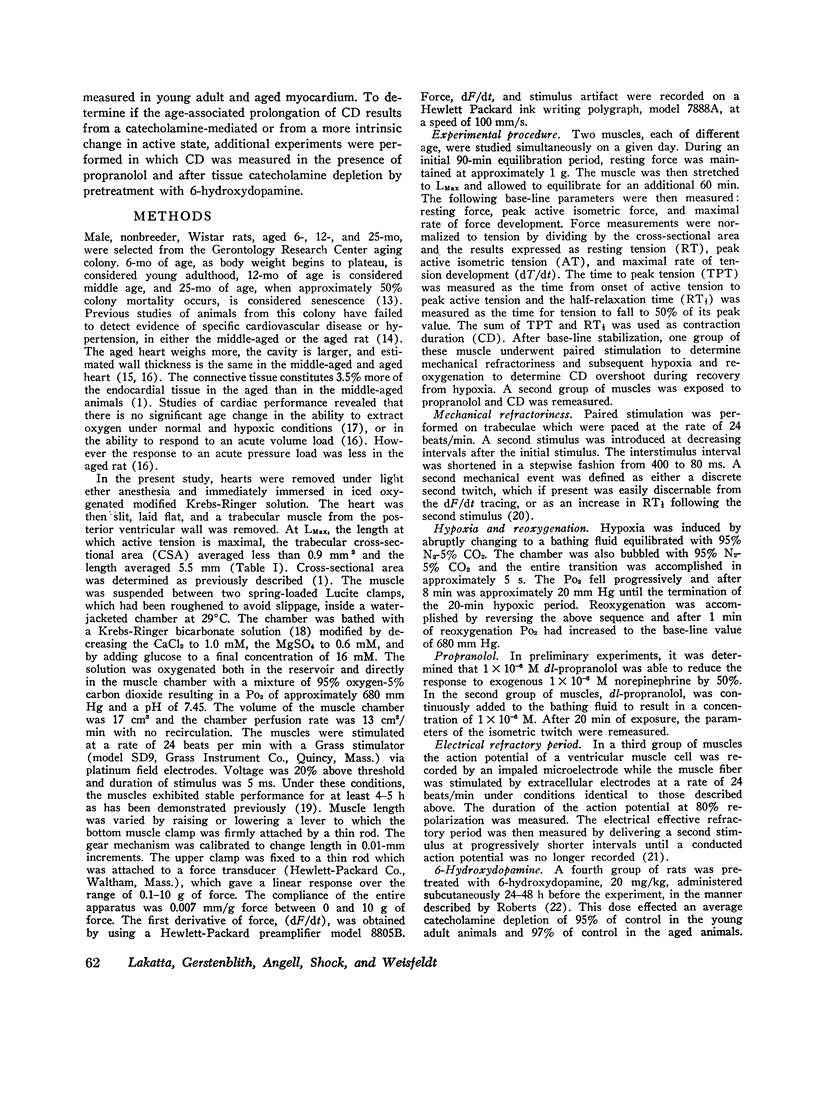
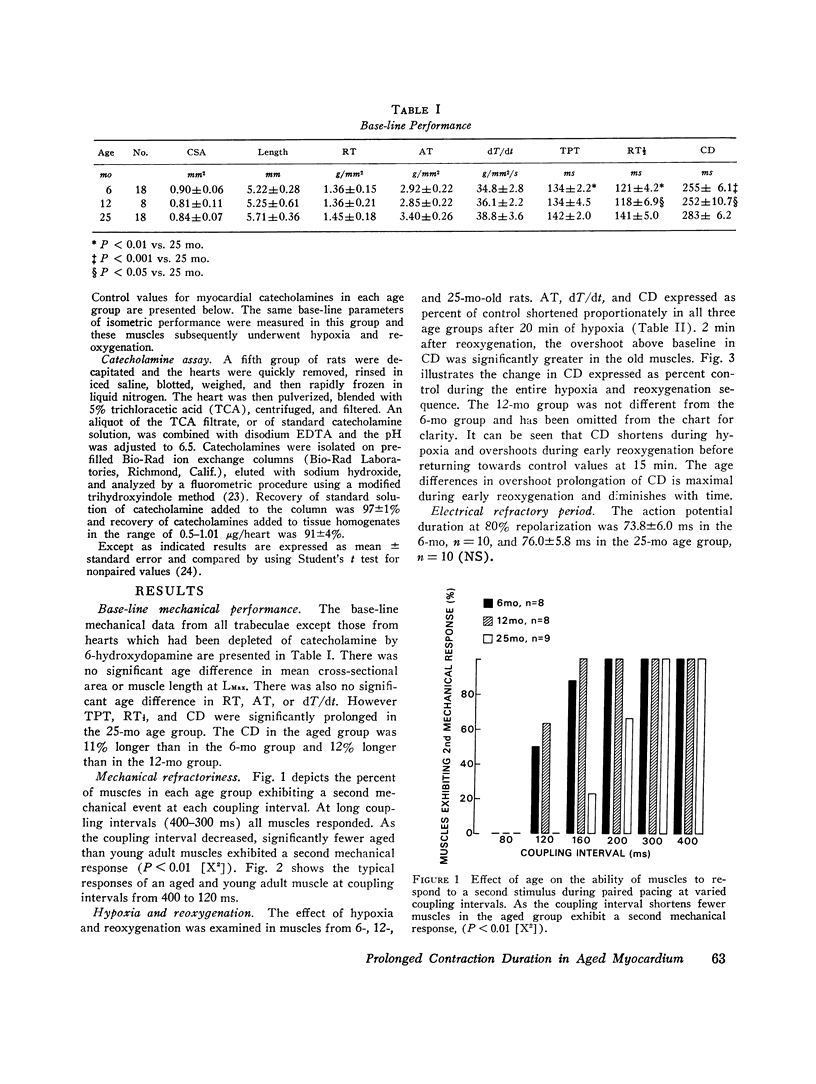
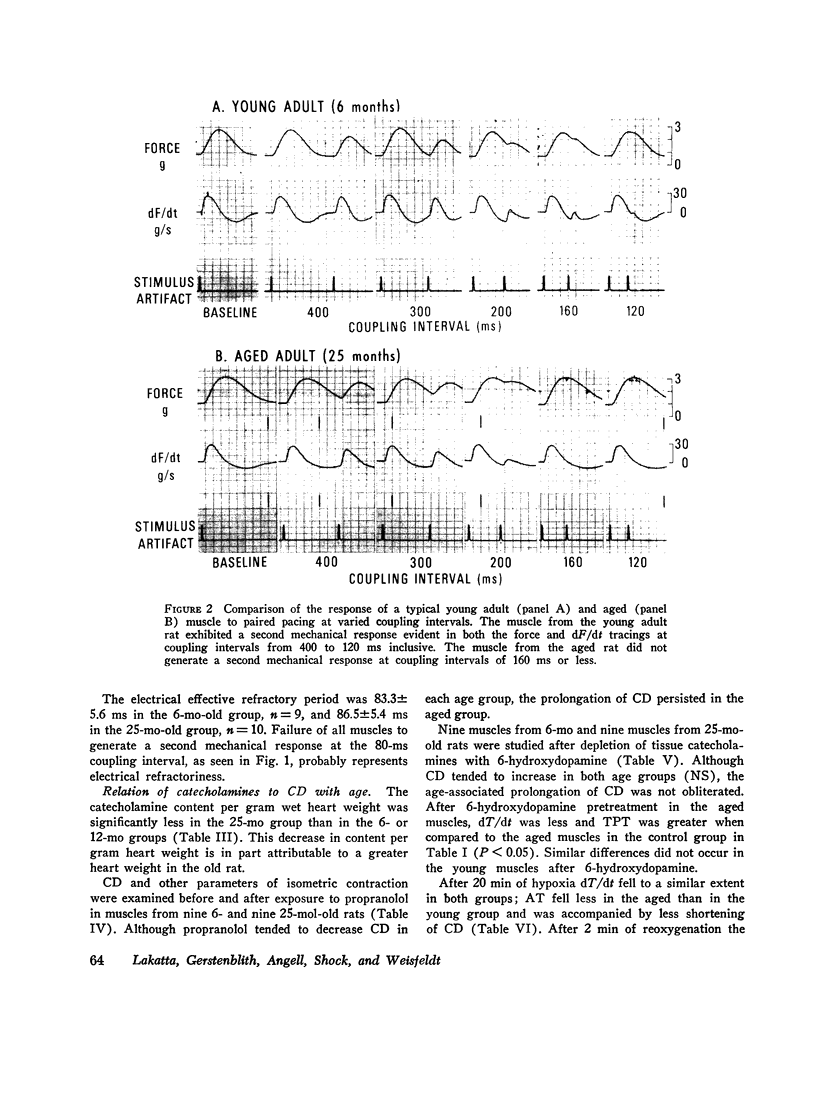
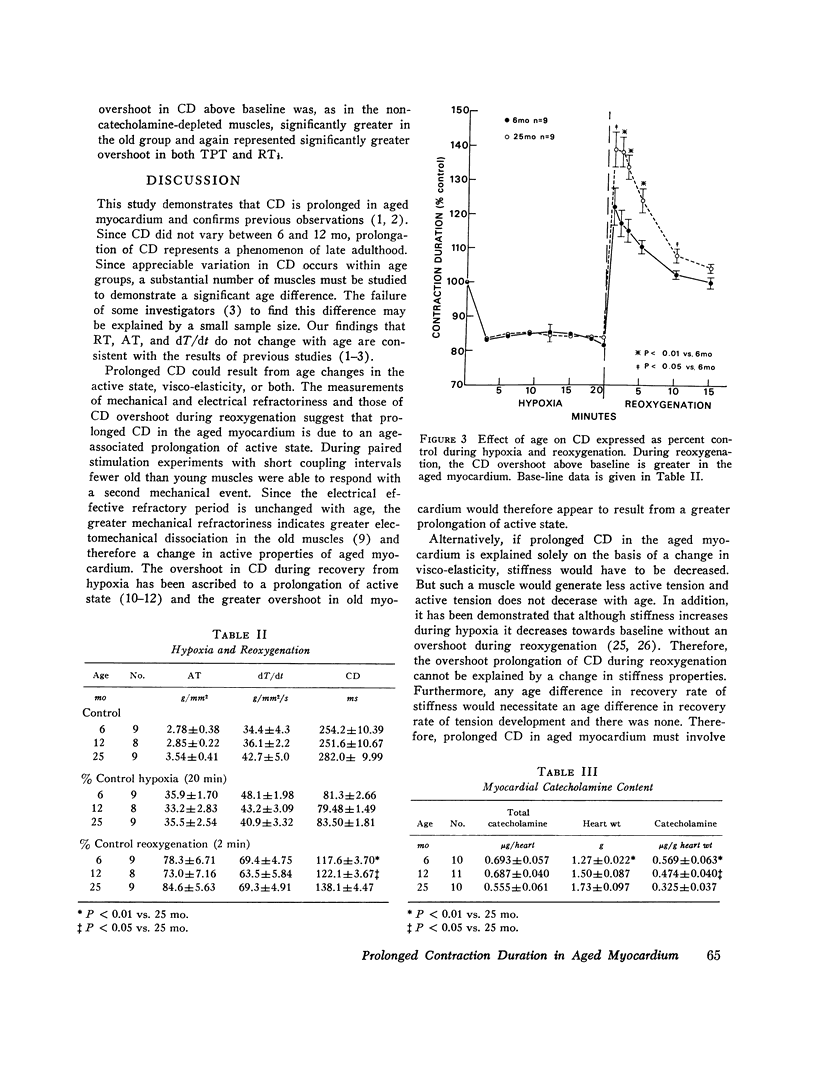
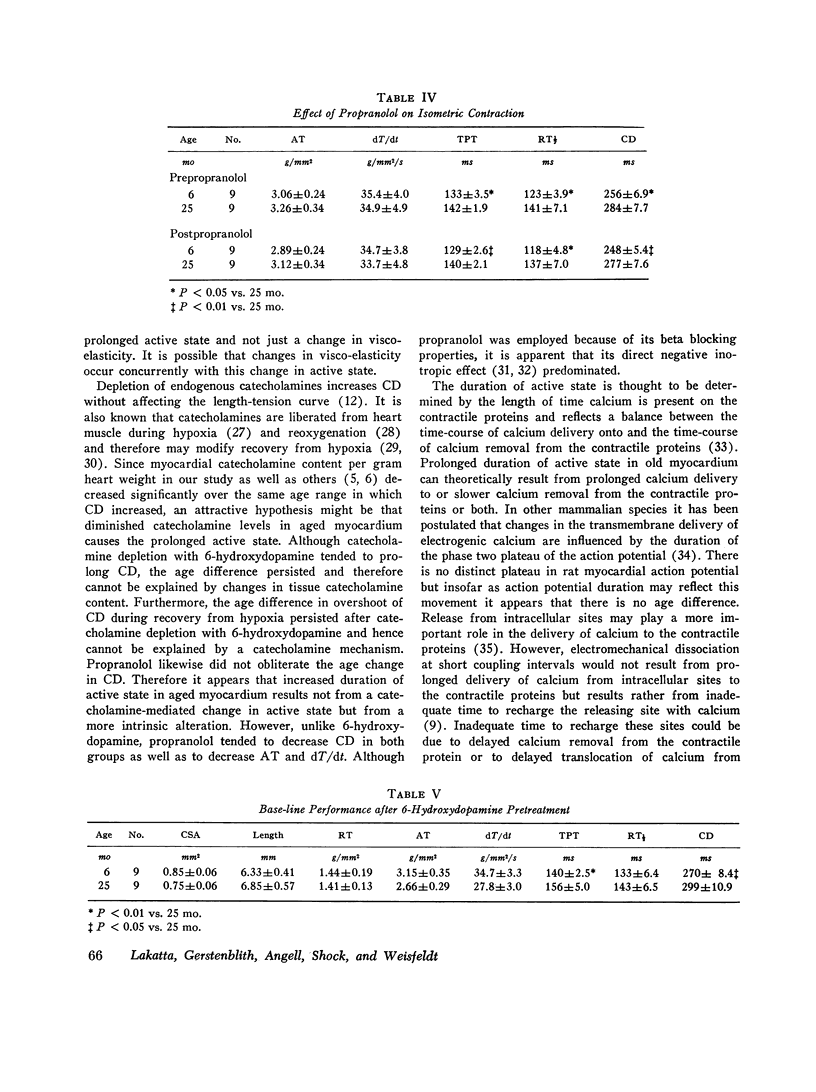
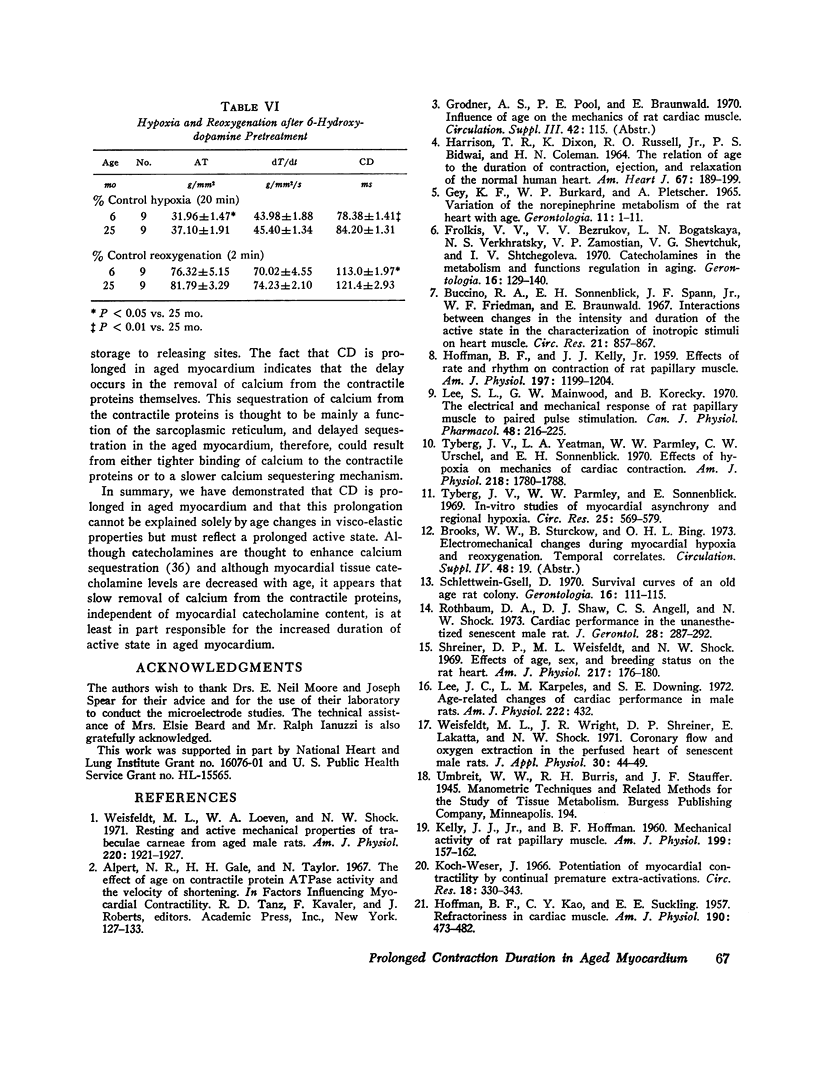
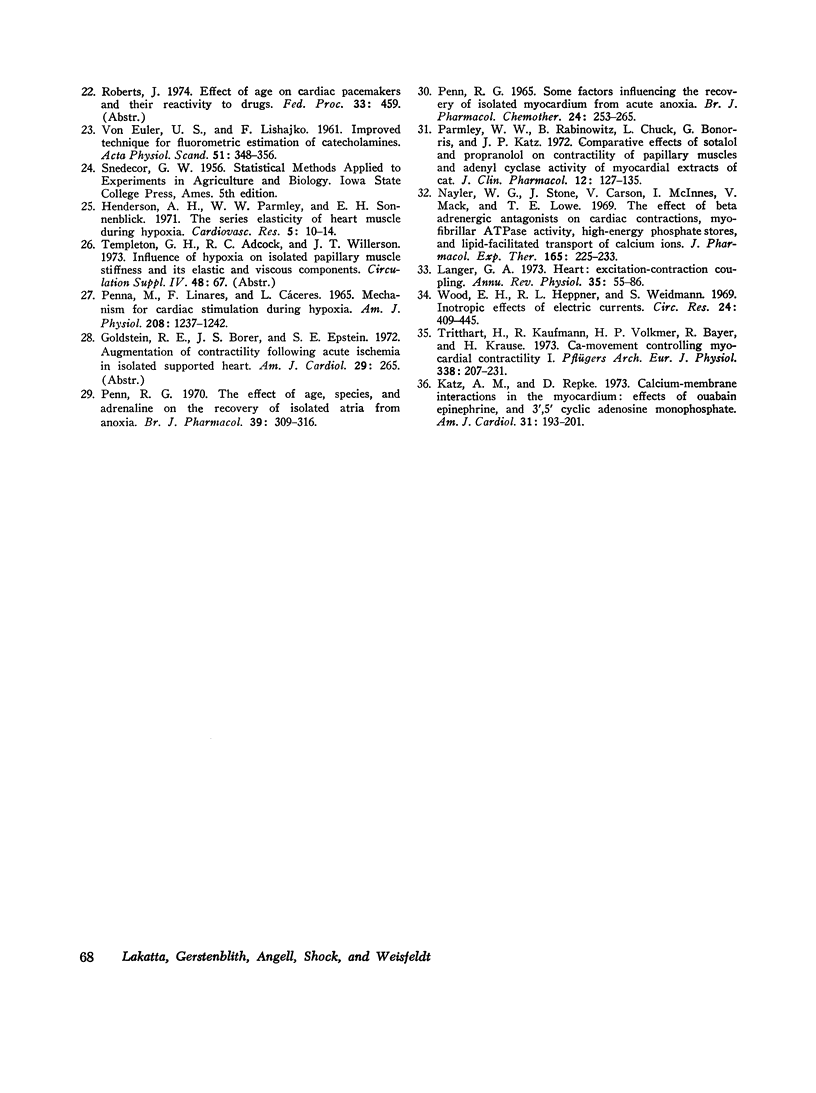
Images in this article
Selected References
These references are in PubMed. This may not be the complete list of references from this article.
- Buccino R. A., Sonnenblick E. H., Spann J. F., Jr, Friedman W. F., Braunwald E. Interactions between changes in the intensity and duration of the active state in the characterization of inotropic stimuli on heart muscle. Circ Res. 1967 Dec;21(6):857–867. doi: 10.1161/01.res.21.6.857. [DOI] [PubMed] [Google Scholar]
- Frolkis V. V., Bezrukov V. V., Bogatskaya L. N., Verkhratsky N. S., Zamostian V. P., Shevtchuk V. G., Shtchegoleva I. V. Catecholamines in the metabolism and functions regulation in aging. Gerontologia. 1970;16(3):129–140. doi: 10.1159/000211765. [DOI] [PubMed] [Google Scholar]
- Gey K. F., Burkard W. P., Pletscher A. Variation of the norepinephrine metabolism of the rat heart with age. Gerontologia. 1965;11(1):1–11. doi: 10.1159/000211461. [DOI] [PubMed] [Google Scholar]
- HARRISON T. R., DIXON K., RUSSELL R. O., Jr, BIDWAI P. S., COLEMAN H. N. THE RELATION OF AGE TO THE DURATION OF CONTRACTION, EJECTION, AND RELAXATION OF THE NORMAL HUMAN HEART. Am Heart J. 1964 Feb;67:189–199. doi: 10.1016/0002-8703(64)90370-9. [DOI] [PubMed] [Google Scholar]
- HOFFMAN B. F., KAO C. Y., SUCKLING E. E. Refractoriness in cardiac muscle. Am J Physiol. 1957 Sep;190(3):473–482. doi: 10.1152/ajplegacy.1957.190.3.473. [DOI] [PubMed] [Google Scholar]
- HOFFMAN B. F., KELLY J. J., Jr Effects of rate and rhythm on contraction of rat papillary muscle. Am J Physiol. 1959 Dec;197:1199–1204. doi: 10.1152/ajplegacy.1959.197.6.1199. [DOI] [PubMed] [Google Scholar]
- Henderson A. H., Parmley W. W., Sonnenblick E. H. The series elasticity of heart muscle during hypoxia. Cardiovasc Res. 1971 Jan;5(1):10–14. doi: 10.1093/cvr/5.1.10. [DOI] [PubMed] [Google Scholar]
- KELLY J. J., Jr, HOFFMAN B. F. Mechanical activity of rat papillary muscle. Am J Physiol. 1960 Jul;199:157–162. doi: 10.1152/ajplegacy.1960.199.1.157. [DOI] [PubMed] [Google Scholar]
- Katz A. M., Repke D. I. Calcium-membrane interactions in the myocardium: effects of ouabain, epinephrine and 3',5'-cyclic adenosine monophosphate. Am J Cardiol. 1973 Feb;31(2):193–201. doi: 10.1016/0002-9149(73)91032-1. [DOI] [PubMed] [Google Scholar]
- Koch-Weser J. Potentiation of myocardial contractility by continual premature extra-activations. Circ Res. 1966 Mar;18(3):330–343. doi: 10.1161/01.res.18.3.330. [DOI] [PubMed] [Google Scholar]
- Langer G. A. Heart: excitation-contraction coupling. Annu Rev Physiol. 1973;35:55–86. doi: 10.1146/annurev.ph.35.030173.000415. [DOI] [PubMed] [Google Scholar]
- Lee J. C., Karpeles L. M., Downing S. E. Age-related changes of cardiac performance in male rats. Am J Physiol. 1972 Feb;222(2):432–438. doi: 10.1152/ajplegacy.1972.222.2.432. [DOI] [PubMed] [Google Scholar]
- Lee S. L., Mainwood G. W., Korecky B. The electrical and mechanical response of rat papillary muscle to paired pulse stimulation. Can J Physiol Pharmacol. 1970 Apr;48(4):216–225. doi: 10.1139/y70-039. [DOI] [PubMed] [Google Scholar]
- Nayler W. G., Stone J., Carson V., McInnes I., Mack V., Lowe T. E. The effect of beta adrenergic antagonists on cardiac contractions, myofibrillar ATPase activity, high-energy phosphate stores and lipid-facilitated transfort of calciumiones. J Pharmacol Exp Ther. 1969 Feb;165(2):225–233. [PubMed] [Google Scholar]
- PENNA M., LINARES F., CACERES L. MECHANISM FOR CARDIAC STIMULATION DURING HYPOXIA. Am J Physiol. 1965 Jun;208:1237–1242. doi: 10.1152/ajplegacy.1965.208.6.1237. [DOI] [PubMed] [Google Scholar]
- PENN R. G. SOME FACTORS INFLUENCING THE RECOVERY OF ISOLATED MYOCARDIUM FROM ACUTE ANOXIA. Br J Pharmacol Chemother. 1965 Feb;24:253–265. doi: 10.1111/j.1476-5381.1965.tb02101.x. [DOI] [PMC free article] [PubMed] [Google Scholar]
- Parmley W. W., Rabinowitz B., Chuck L., Bonorris G., Katz J. P. Comparative effects of sotalol and propranolol on contractility of papillary muscles and adenyl cyclase activity of myocardial extracts of cat. J Clin Pharmacol New Drugs. 1972 Apr;12(4):127–135. doi: 10.1002/j.1552-4604.1972.tb00041.x. [DOI] [PubMed] [Google Scholar]
- Penn R. G. The effect of age, species and adrenaline on the recovery of isolated atria from anoxia. Br J Pharmacol. 1970 Jun;39(2):309–316. doi: 10.1111/j.1476-5381.1970.tb12894.x. [DOI] [PMC free article] [PubMed] [Google Scholar]
- Rothbaum D. A., Shaw D. J., Angell C. S., Shock N. W. Cardiac performance in the unanesthetized senescent male rat. J Gerontol. 1973 Jul;28(3):287–292. doi: 10.1093/geronj/28.3.287. [DOI] [PubMed] [Google Scholar]
- Schlettwein-Gsell D. Survival curves of an old age rat colony. Gerontologia. 1970;16(2):111–115. doi: 10.1159/000211762. [DOI] [PubMed] [Google Scholar]
- Shreiner D. P., Weisfeldt M. L., Shock N. W. Effects of age, sex, and breeding status on the rat heart. Am J Physiol. 1969 Jul;217(1):176–180. doi: 10.1152/ajplegacy.1969.217.1.176. [DOI] [PubMed] [Google Scholar]
- Tritthart H., Kaufmann R., Volkmer H. P., Bayer R., Krause H. Ca-movement controlling myocardial contractility. I. Voltage-, current- and time-dependence of mechanical activity under voltage clamp conditions (cat papillary muscles and trabeculae). Pflugers Arch. 1973 Feb 6;338(3):207–231. doi: 10.1007/BF00587388. [DOI] [PubMed] [Google Scholar]
- Tyberg J. V., Parmley W. W., Sonnenblick E. H. In-vitro studies of myocardial asynchrony and regional hypoxia. Circ Res. 1969 Nov;25(5):569–579. doi: 10.1161/01.res.25.5.569. [DOI] [PubMed] [Google Scholar]
- Tyberg J. V., Yeatman L. A., Parmley W. W., Urschel C. W., Sonnenblick E. H. Effects of hypoxia on mechanics of cardiac contraction. Am J Physiol. 1970 Jun;218(6):1780–1788. doi: 10.1152/ajplegacy.1970.218.6.1780. [DOI] [PubMed] [Google Scholar]
- Weisfeldt M. L., Loeven W. A., Shock N. W. Resting and active mechanical properties of trabeculae carneae from aged male rats. Am J Physiol. 1971 Jun;220(6):1921–1927. doi: 10.1152/ajplegacy.1971.220.6.1921. [DOI] [PubMed] [Google Scholar]
- Weisfeldt M. L., Wright J. R., Shreiner D. P., Lakatta E., Shock N. W. Coronary flow and oxygen extraction in the perfused heart of senescent male rats. J Appl Physiol. 1971 Jan;30(1):44–49. doi: 10.1152/jappl.1971.30.1.44. [DOI] [PubMed] [Google Scholar]
- Wood E. H., Heppner R. L., Weidmann S. Inotropic effects of electric currents. I. Positive and negative effects of constant electric currents or current pulses applied during cardiac action potentials. II. Hypotheses: calcium movements, excitation-contraction coupling and inotropic effects. Circ Res. 1969 Mar;24(3):409–445. doi: 10.1161/01.res.24.3.409. [DOI] [PubMed] [Google Scholar]
- von EULER U., LISHAJKO F. Improved technique for the fluorimetric estimation of catecholamines. Acta Physiol Scand. 1961 Apr;51:348–355. doi: 10.1111/j.1748-1716.1961.tb02128.x. [DOI] [PubMed] [Google Scholar]




